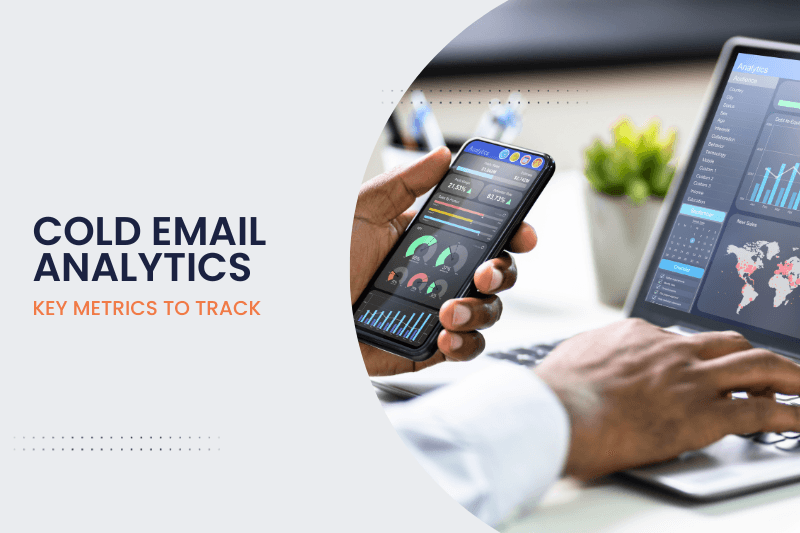Cold Email
Key Metrics to Track with Cold Email Analytics
Unlocking the secrets to agency success might seem daunting, but it's closer than you think. Cold email analytics are your hidden ace, transforming your outreach from shots in the dark to strategic moves.
Dec 1, 2023

Imagine knowing exactly what works and what doesn't in your cold email campaigns. You're not just sending emails; you're crafting opportunities.
Let's explore how cold email analytics can help you pinpoint the winning formula for your agency's growth and client acquisition. It's time to leave guesswork behind and embrace data-driven strategies.
Understanding Cold Email Analytics
Cold email analytics involves collecting and assessing data from cold email campaigns to inform future strategies. It's the process of measuring different metrics to understand how recipients interact with your emails.
These metrics typically include:
Open rate: the percentage of recipients who open an email.
Click-through rate (CTR): the percentage of recipients who clicked on a link within the email.
Response rate: the percentage of recipients who replied to the email.
Conversion rate: the number of recipients who took the desired action, such as signing up for a service or purchasing a product.
Cold email analytics tools collect this data and construct a performance overview, giving you actionable insights into the effectiveness of your outreach efforts.
Why is Cold Email Analytics Important for Agencies?
For agencies, understanding and optimizing cold email performance is vital for ongoing success.
Here's why:
Boosts Open Rates: By analyzing which subject lines garner the most opens, you can refine your approach to grab attention instantly.
Enhances Engagement: Discover which email content drives action, whether it’s clicking a link or replying to a message.
Optimizes Campaign Timing: Analytics show you when recipients are most likely to engage, allowing you to schedule emails for maximum impact.
Refines Targeting: Learn which segments of your audience are most receptive and tailor your campaigns to these groups.
Increase ROI: Understanding which emails convert leads to customers helps you focus on the most lucrative strategies, maximizing your return on investment.
For agencies, leveraging cold email analytics isn't just about improving individual metrics but about comprehensively enhancing email campaigns for better client acquisition and retention.
By continually monitoring and adapting based on these analytics, you can ensure that your agency remains competitive and results-driven in a crowded digital marketplace.
Key Metrics to Track in Cold Email Analytics
Understanding the key metrics in cold email analytics can help you refine your strategy and attain the success you aim for.
Here's what you need to track closely:
1. Open Rate
Open Rate is the percentage of recipients who opened your cold emails. It's a critical indicator of the initial interest your email generates.
A high open rate can suggest a strong subject line and sender reputation, while a low one signals that it's time to reevaluate your approach.
To improve your open rate, consider personalizing your emails and optimizing your subject lines for curiosity and relevance.
2. Click-Through Rate (CTR)
The Click-Through Rate (CTR) measures how many recipients clicked on a link within your email. It provides insight into how compelling your message and call-to-action (CTA) are.
Elevating your CTR often involves crafting more engaging content and offering clear, irresistible CTAs that resonate with your audience's needs and desires.
3. Conversion Rate
Your Conversion Rate is the percentage of recipients who took the desired action after clicking a link in your email, such as making a purchase or signing up for a webinar. This metric directly ties to the effectiveness of your email campaign.
To enhance your conversion rate, ensure that your landing pages are aligned with your email promises and streamlined for a smooth user experience.
4. Bounce Rate
The Bounce Rate reflects the percentage of emails that were undeliverable and returned by the recipient's server. Keep track of your bounce rate to maintain a clean email list and solid sender reputation.
Regularly cleansing your list of invalid addresses can significantly decrease your bounce rate.
5. Unsubscribe Rate
Your Unsubscribe Rate indicates how many people opted out of your email list after receiving an email.
It's normal to have some unsubscribers, but a higher rate may mean it's time to reassess the relevancy and frequency of your content. Aim to provide value in every email to minimize this rate.
6. Reply Rate
Monitoring the Reply Rate will tell you how many recipients are engaging in conversation by replying to your emails.
A strong reply rate can be a signal of an engaged audience and a compelling message. Foster higher reply rates by crafting emails that encourage dialogue and show genuine interest in the recipient's feedback or business needs.
7. Forward Rate
The Forward Rate indicates the percentage of recipients who forwarded your email to others. A notable forward rate can expand your reach and potentially grow your audience organically.
You can boost this metric by creating share-worthy content that's valuable enough for recipients to send to their peers.
8. Spam Rate
Lastly, the Spam Rate is the percentage of your emails marked as spam by the recipients.
It is crucial to keep this rate as low as possible to ensure deliverability and maintain a positive sender reputation. Adhering to email marketing best practices and respecting consent guidelines will help keep your spam rate to a minimum.
Tools to Track Cold Email Analytics
Understanding the nuances of cold email analytics requires reliable tools or software that facilitate tracking and analysis.
Utilizing the right software can save you countless hours and improve your campaigns exponentially.
In this section, we'll explore essential tools that should be a part of your arsenal.
1. Email Marketing Platforms
When you're running an agency, robust email marketing platforms are indispensable. Platforms like Mailchimp, Constant Contact, and SendinBlue offer built-in analytics that are crucial for monitoring your campaigns:
Track open rates and click-through rates seamlessly
Manage your contacts and segment them based on behavior
View reports that highlight the success of your campaigns
These platforms come with intuitive dashboards that offer a visual representation of your campaign's performance, making it easier to digest complex data.
Automation features also allow you to trigger emails based on specific actions, further refining your strategy.
2. Google Analytics Integration
For a more in-depth analysis, integrating your email campaigns with Google Analytics can be a game-changer. This integration enables you to track how recipients interact with your website after clicking a link in your email:
Set up goals to monitor conversions from email traffic
View the behavior flow to understand the user journey
Analyze the acquisition reports to see how your emails contribute to traffic
Remember to tag your email links with UTM parameters. This way, you'll have precise data on the effectiveness of your email campaigns in driving web traffic and conversions.
3. Email Tracking Software
There's an array of specialized email tracking software dedicated to providing granular details on your cold email campaigns. Tools like Yesware, Bananatag, and HubSpot's email tracking functionality can elevate your analytics with features like:
Real-time notifications when emails are opened
Link tracking to see which content garners more engagement
Detailed reports on reply rates and follow-up efficiency
Investing in these tools means you're not only sending emails but also gathering strategic data that informs your decision-making process.
Whether it's A/B testing subject lines or pinpointing the best time to send follow-ups, email tracking software is important.
By incorporating these tools into your analytics strategy, you'll be equipped to fine-tune your cold email campaigns for maximum impact. Remember, the more data you have, the better your ability to connect with prospects and drive meaningful business growth.
Analyzing and Interpreting Cold Email Analytics
1. A/B Testing
A/B testing, or split testing, is crucial for improving your cold email campaigns. Here, you'll test two variations of the same email to see which performs better. Focus on single-variable changes such as subject lines, email content, or call-to-action buttons.
By doing so, you can determine which elements resonate with your audience and lead to better conversion rates.
Send Variation A to half of your list and Variation B to the other half.
Monitor which version yields a higher open rate or click-through rate.
Use the results to refine your future emails for increased engagement.
2. Segmentation and Personalization
Different audiences have different needs and preferences, which you should address through segmentation and personalization.
Segment your email list based on demographics, past behavior, or engagement levels. Tailor your messages to match the interests of each segment, which can significantly boost open and reply rates.
Segment lists by industry, job title, or activity on your website.
Personalize emails with the recipient's name, company, or recent interactions.
Analyze performance to see which segments are most responsive.
3. Tracking Campaign Performance Over Time
Long-term data analysis is key to understanding campaign success. You'll want to track the performance of your cold email campaigns over weeks, months, or even years.
This will help you spot trends such as seasonal variations or the best times to send your emails.
Compare current campaign metrics with past performance.
Note any shifts in engagement or conversion rates.
Calculate your overall ROI to determine campaign effectiveness.
4. Identifying Trends and Patterns
Detecting trends and patterns in your cold email analytics allows for data-driven decisions. You might discover that certain phrases increase open rates or that specific industries prefer a certain type of content.
With this knowledge, you can tailor your approach for better results.
Look for patterns at times when engagement peaks.
Track which types of content generate more conversions.
Identify which days of the week yield higher open rates.
5. Adjusting and Optimizing Cold Email Strategy
When you've gathered enough data, it's time to adjust and optimize your cold email strategy. Make informed decisions on everything from your sending frequency to the design elements of your emails.
Remember, optimization is an ongoing process, and what works now might need tweaking in the future.
Adjust your sending schedule based on engagement data.
Refine email content and design for an improved reader experience.
Test new strategies continuously to keep improving your metrics.
Using Cold Email Analytics to Improve Agency Success
1. Increasing Client Acquisition and Retention
Tracking cold email metrics is a game-changer for boosting your client base. By analyzing which campaigns garner the most interest, you're armed with powerful insights to attract new clients.
Open rate and click-through rate serve as your first indicators of an email's appeal. But don't stop there. Dive into the conversion rate to see how many readers are taking action.
Noticing patterns in these metrics will guide you in crafting emails that resonate, thereby increasing the likelihood of acquiring new clients.
Retention is the other side of the acquisition coin. Keep an eye on unsubscribe rates and feedback from your clients.
A spike in unsubscribes or negative feedback is a red flag that your content may not be hitting the mark. Address these issues quickly by adjusting your approach, ensuring you keep existing clients engaged and loyal.
2. Understanding Client Needs and Preferences
Success in any agency hinges on understanding your client's needs. Cold email analytics provide a crystal-clear picture of what piques the interest of your audience.
Segmentation is your ally here; break down your analytics by demographics, past behavior, and engagement levels.
Reply rates and forward rates are key to gauging content resonance and potential interest in your services.
Tailoring your communication based on these insights ensures your messages are relevant and compelling, thus building a strong relationship with your clients.
3. Improving Email Engagement and Conversion Rates
High engagement and conversion rates signify a thriving cold email strategy. But there's always room for improvement. Use A/B testing to experiment with different subject lines, email formats, and calls to action.
This process of trial and error lets you fine-tune every aspect of your email, from the subject line that gets more opens to the content that drives conversions.
Moreover, integrate email tracking software to gain a deeper understanding of how recipients interact with your emails post-click.
Such tools reveal which links were clicked, how much time was spent on your content, and what ultimately led to a conversion. Leverage this data to iterate and enhance subsequent campaigns.
By persistently refining your emails based on analytics, you'll see a steady climb in both engagement and conversion rates.
Conclusion
Harnessing the power of cold email analytics is a game-changer for your agency's success. By paying close attention to key metrics, you're equipped to make informed decisions that boost email performance and ROI.
Remember, it's not just about sending emails—it's about sending the right emails to the right people at the right time.
With the right tools and a strategic approach to analytics, you'll not only meet your client's needs but exceed them, ensuring your agency stands out in a crowded market.
Start optimizing your cold email campaigns today and watch your client list—and your agency—flourish.

